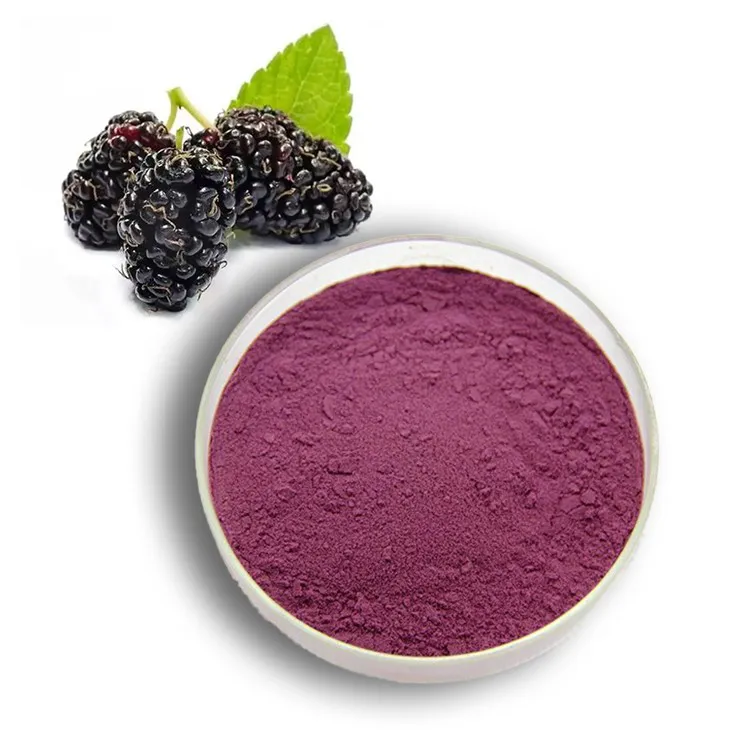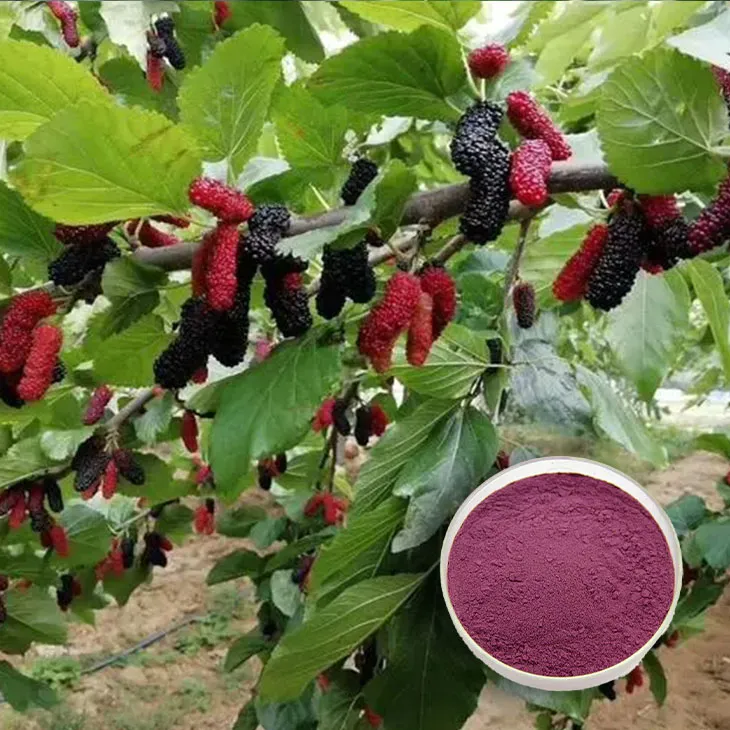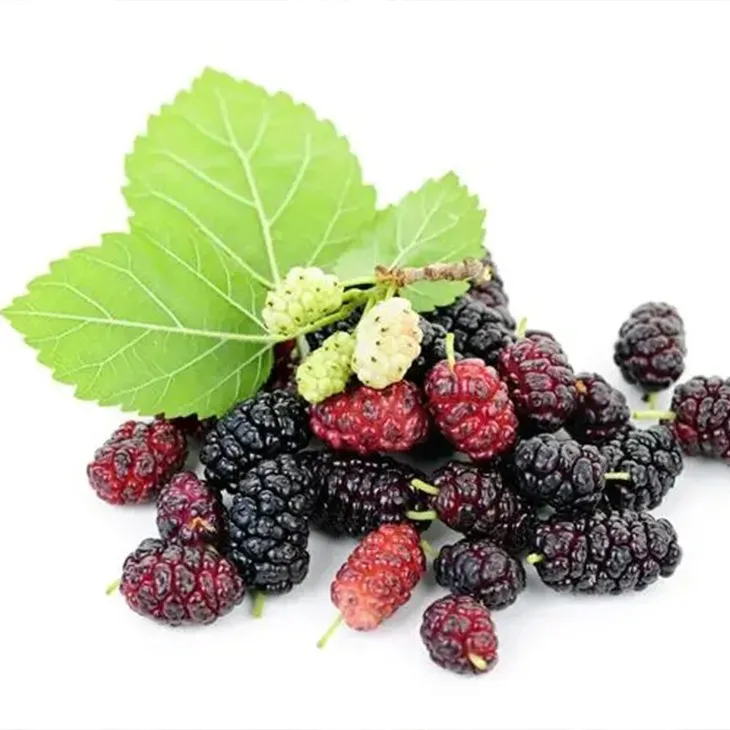- 0086-571-85302990
- sales@greenskybio.com
Optimal Bioavailability of Mulberry Extract.
2024-11-27

1. Introduction
Mulberry Extract has been gaining significant attention in the fields of health and wellness due to its potential beneficial properties. However, to fully realize its potential, understanding and maximizing its bioavailability is crucial. Bioavailability refers to the proportion of a substance that enters the circulation and is able to have an active effect. In the case of Mulberry Extract, various factors can influence how much of the active compounds are actually absorbed and utilized by the body.

2. Mulberry Extract: An Overview
2.1 Composition
Mulberry extract contains a rich array of bioactive compounds. These include flavonoids such as rutin and Quercetin, which are known for their antioxidant properties. Additionally, it contains phenolic acids and alkaloids. These components work in concert to potentially provide health benefits such as anti - inflammatory effects, blood sugar regulation, and cardiovascular protection.2.2 Traditional and Modern Uses
In traditional medicine, mulberry has been used for various purposes, including treating diabetes and improving eyesight. In modern times, research is exploring its potential in more areas such as anti - aging and immune system modulation. However, for these potential benefits to be fully realized, the bioavailability of the extract needs to be optimized.
3. Factors Influencing Bioavailability
3.1 Extraction Methods
- Solvent - based extraction: Different solvents can be used to extract mulberry extract. For example, ethanol - based extraction is commonly used. The choice of solvent can affect the yield and the composition of the extract. Ethanol may be more effective in extracting certain flavonoids compared to water. However, the residual solvent in the extract needs to be carefully controlled as it may affect bioavailability and safety.
- Supercritical fluid extraction: This method uses supercritical carbon dioxide. It has the advantage of being a clean and efficient extraction method. It can selectively extract certain compounds while leaving behind unwanted substances. This can result in a purer extract with potentially higher bioavailability as it contains a higher proportion of the active compounds.
- Enzyme - assisted extraction: Enzymes can be used to break down the cell walls of mulberry plants, making it easier to extract the bioactive compounds. This method can increase the yield of extraction and may also improve the bioavailability as the released compounds are in a more accessible form.
3.2 Formulation
- Capsule vs. Tablet: The form in which the mulberry extract is presented can impact bioavailability. Capsules may be easier to digest and release the extract more quickly compared to tablets. Tablets, on the other hand, may be more stable and have a longer shelf - life. However, proper formulation techniques are required to ensure that the active compounds are released in a bioavailable form in both cases.
- Additives and Excipients: The addition of certain additives and excipients can either enhance or hinder bioavailability. For example, adding a surfactant can improve the solubility of the extract in the gastrointestinal tract, thereby increasing absorption. However, some fillers may reduce the overall bioactivity if they interact unfavorably with the active compounds.
3.3 Delivery Systems
- Nanoparticle - based Delivery: Nanoparticles can be used to encapsulate mulberry extract. This has the potential to protect the active compounds from degradation in the digestive tract and also enhance their absorption. Nanoparticles can be designed to target specific cells or tissues, increasing the effectiveness of the extract at the desired site.
- Liposomal Delivery: Liposomes are lipid - based vesicles that can encapsulate the extract. They mimic the cell membrane structure, which can facilitate better absorption. Liposomal delivery can also protect the extract from enzymatic degradation in the body, improving its bioavailability.

4. Scientific Research on Bioavailability Optimization
4.1 In - vitro Studies
Many in - vitro studies have been conducted to evaluate the bioavailability of mulberry extract. These studies involve using cell cultures to mimic the absorption process in the body. For example, researchers may expose intestinal cell monolayers to different formulations of mulberry extract to determine which formulation results in the highest uptake of the active compounds. These studies provide valuable initial insights into the factors that may affect bioavailability, but they have limitations as they do not fully replicate the complex in - vivo environment.4.2 In - vivo Studies
In - vivo studies are more comprehensive as they involve animal or human subjects. In animal studies, researchers can measure the absorption, distribution, metabolism, and excretion (ADME) of mulberry extract. For example, they may feed animals with different formulations of mulberry extract and then analyze the levels of active compounds in the blood, tissues, and excreta. In human studies, factors such as bioavailability, safety, and efficacy are evaluated. These studies often require strict ethical approval and careful study design, but they provide the most accurate information on how to optimize the bioavailability of mulberry extract for human health and wellness.5. Strategies for Maximizing Bioavailability
5.1 Selection of Optimal Extraction Method
Based on the available scientific research, the supercritical fluid extraction method may be a good choice for maximizing the bioavailability of mulberry extract. It can produce a high - quality extract with a high proportion of active compounds while minimizing the presence of unwanted substances. However, cost - effectiveness and scalability also need to be considered when choosing an extraction method.5.2 Appropriate Formulation Design
When formulating mulberry extract products, a capsule form with appropriate additives such as surfactants may be beneficial. This can improve the solubility and absorption of the extract in the gastrointestinal tract. Additionally, the use of time - release formulations can also be explored to ensure a sustained release of the active compounds, maximizing their bioavailability over a longer period.5.3 Advanced Delivery Systems
Incorporating nanoparticle - or liposomal - based delivery systems can significantly enhance the bioavailability of mulberry extract. These systems can protect the active compounds from degradation and improve their uptake by cells. However, further research is needed to ensure their safety and effectiveness in long - term use.6. Conclusion
Maximizing the bioavailability of mulberry extract is a complex but important task. By understanding the factors that influence bioavailability, such as extraction methods, formulation, and delivery systems, and by conducting comprehensive scientific research, we can develop strategies to optimize the use of mulberry extract in health and wellness. Continued research in this area will not only benefit the development of mulberry - based products but also contribute to the overall understanding of natural product bioavailability and their potential applications in human health.
FAQ:
What are the common extraction methods for mulberry extract?
Common extraction methods for mulberry extract include solvent extraction, such as using ethanol or water as solvents. Supercritical fluid extraction is also an option. Solvent extraction is relatively straightforward and cost - effective. Supercritical fluid extraction, often using carbon dioxide, can produce a purer extract with potentially better quality in terms of bioactive compounds, but it is more technically demanding and costly.
How does the formulation affect the bioavailability of mulberry extract?
The formulation can have a significant impact on the bioavailability of mulberry extract. For example, if it is formulated in a capsule with appropriate excipients, it can protect the extract from degradation in the stomach and enhance its absorption in the intestine. Combining the mulberry extract with other substances like lipids or surfactants in a formulation can also improve its solubility and thus its bioavailability, as some components of the mulberry extract may be hydrophobic and need help to be dissolved and absorbed.
What are the effective delivery systems for mulberry extract?
Nanoparticle - based delivery systems can be effective for mulberry extract. Nanoparticles can encapsulate the extract and target specific cells or tissues in the body, enhancing its bioavailability. Liposomes are also a good option as they can mimic the cell membrane structure and improve the delivery of the extract. Another delivery system could be microemulsions, which can increase the solubility and stability of the mulberry extract, facilitating its absorption and distribution in the body.
What are the main bioactive compounds in mulberry extract relevant to bioavailability?
Flavonoids, such as rutin and Quercetin, are important bioactive compounds in mulberry extract related to bioavailability. These flavonoids have antioxidant properties and can influence various physiological processes in the body. Anthocyanins are also present, which not only contribute to the color of the mulberry but also have potential health benefits and can affect how the extract is absorbed and utilized in the body. Additionally, alkaloids in the mulberry extract may play a role in its bioactivity and bioavailability.
How can we measure the bioavailability of mulberry extract?
Bioavailability of mulberry extract can be measured through various methods. One common approach is pharmacokinetic studies, which involve administering the extract to test subjects (either animals or humans in appropriate studies) and then measuring the concentration of its bioactive compounds in the blood over time. Another method is to study the excretion of the compounds in urine or feces to estimate how much of the extract has been absorbed and utilized. In vitro models, such as cell culture studies, can also provide some insights into the absorption and uptake mechanisms of the extract, which are related to its bioavailability.
Related literature
- Bioavailability and Health Benefits of Mulberry Extract: A Review"
- "Enhancing the Bioavailability of Mulberry Bioactive Compounds through Advanced Delivery Systems"
- "The Role of Extraction Methods in Determining the Bioavailability of Mulberry Extract"
- ▶ Hesperidin
- ▶ citrus bioflavonoids
- ▶ plant extract
- ▶ lycopene
- ▶ Diosmin
- ▶ Grape seed extract
- ▶ Sea buckthorn Juice Powder
- ▶ Beetroot powder
- ▶ Hops Extract
- ▶ Artichoke Extract
- ▶ Reishi mushroom extract
- ▶ Astaxanthin
- ▶ Green Tea Extract
- ▶ Curcumin Extract
- ▶ Horse Chestnut Extract
- ▶ Other Problems
- ▶ Boswellia Serrata Extract
- ▶ Resveratrol Extract
- ▶ Marigold Extract
- ▶ Grape Leaf Extract
- ▶ blog3
- ▶ blog4
-
Nature's Bounty Vitamin K2
2024-11-27
-
Chinese Saffron Extract Powder Factory.
2024-11-27
-
Cactus Extract Supplier
2024-11-27
-
Optimal Bioavailability of Vitamin C.
2024-11-27
-
Extraction process of wheat germ extract.
2024-11-27
-
Hawthorn Extract
2024-11-27
-
Propolis Extract Powder
2024-11-27
-
Sophora Flavescens Root Extract
2024-11-27
-
Eucommia Ulmoides Extract
2024-11-27
-
Hops Extract
2024-11-27
-
Konjac Powder
2024-11-27
-
Natural grape seed extract
2024-11-27
-
Lemon Extract
2024-11-27
-
Carrageenan Extract Powder
2024-11-27
-
White mustard seed extract
2024-11-27





















